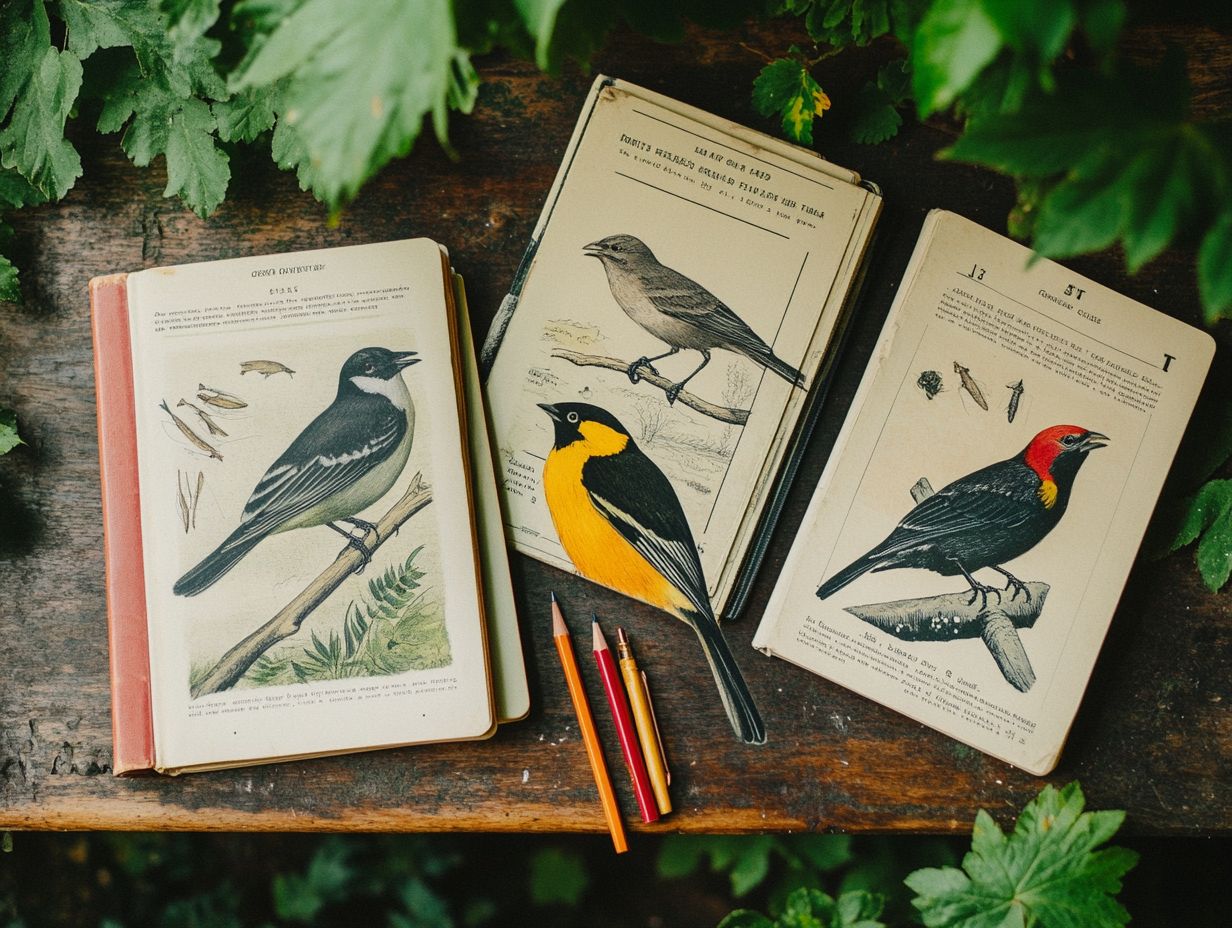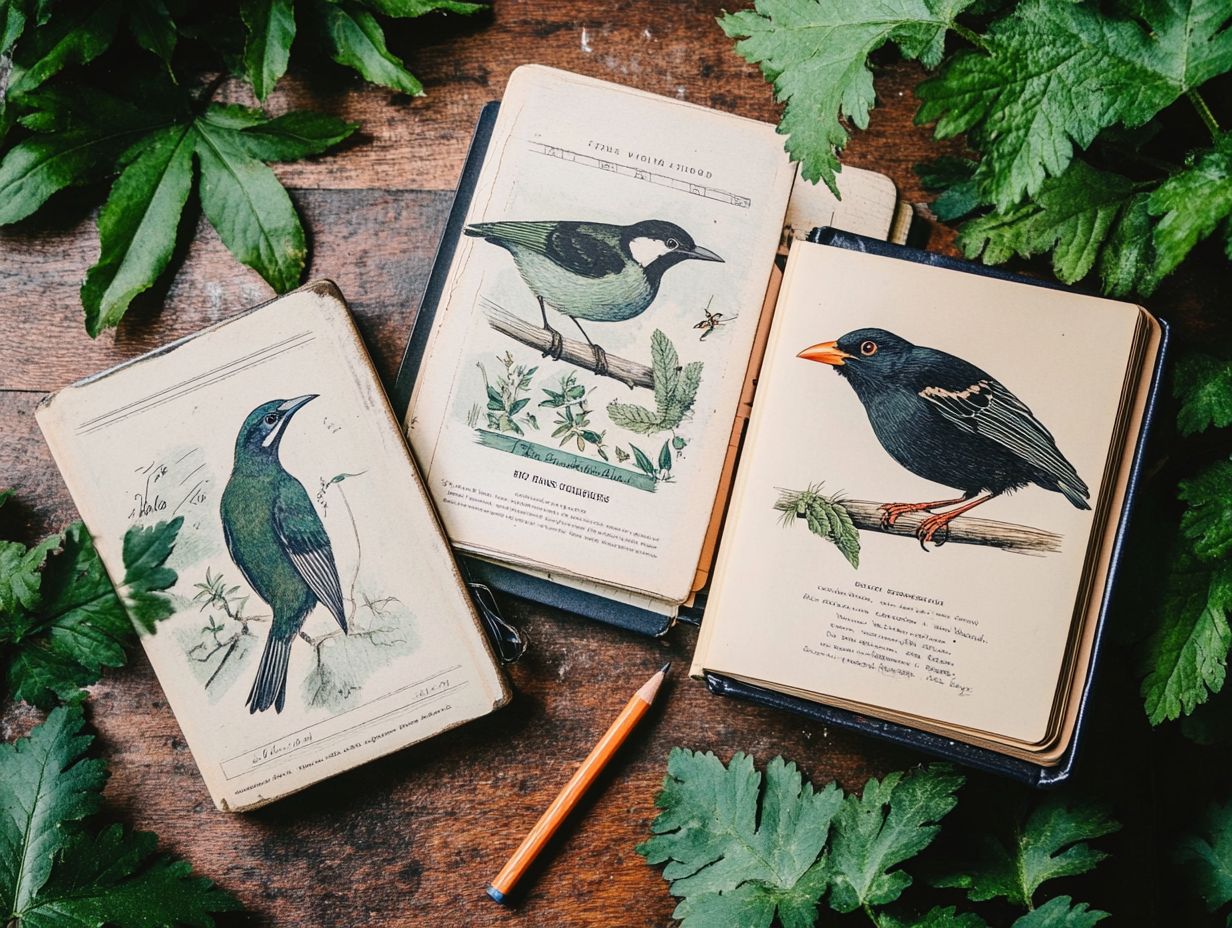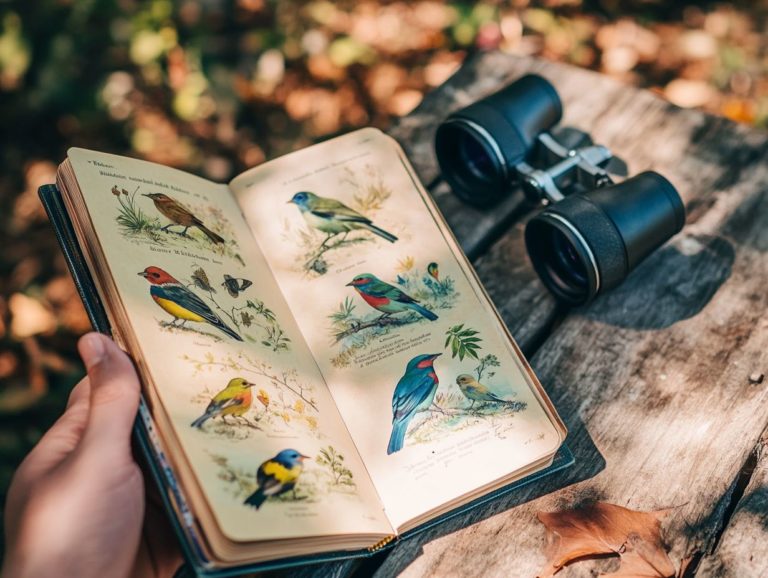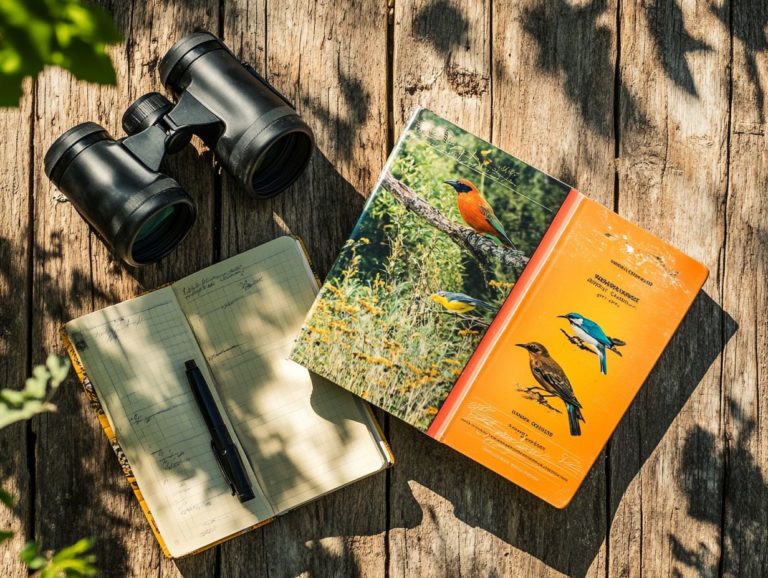Best Field Guides for Bird Identification Techniques
Birdwatching is a truly rewarding pursuit that immerses you in the beauty of nature while offering the thrill of discovery. Whether you’re observing raptors, hummingbirds, or sparrows, each moment is an adventure.
Identifying the vast array of bird species can be quite challenging without the right tools. This article delves into the importance of field guides for bird identification and guides you in selecting the perfect one tailored to your needs. With resources like the Sibley Guide and National Geographic Field Guide, you’ll have access to comprehensive information.
From top recommendations to effective usage tips, it also explores digital options, including popular mobile apps, and shares insights on maintaining your guide.
Immerse yourself in this knowledge to elevate your birdwatching experience!
Contents
- Key Takeaways:
- 1. Importance of Field Guides in Bird Identification
- 2. How to Choose the Right Field Guide for You
- 3. Top 5 Field Guides for Bird Identification
- 4. Features to Look for in a Field Guide
- 5. Tips for Using a Field Guide Effectively
- 6. Common Mistakes in Using Field Guides for Bird Identification
- 7. Digital vs. Print Field Guides
- 8. Additional Resources for Bird Identification
- 9. Field Guide Apps for Bird Identification
- 10. Field Guides for Specific Regions or Countries
- 11. Field Guides for Bird Identification
- 12. Caring for Your Field Guide
- 13. Field Guide Etiquette and Responsible Birding Tips
- 14. The Future of Field Guides and Bird Identification
- Frequently Asked Questions and Bird Identification Tips
- What are the best field guides for bird identification techniques and resources?
- What factors should I consider when choosing a field guide for bird identification?
- Are there beginner-friendly field guides for bird identification?
- Do I need a physical field guide, or are there digital options available?
- Can I use multiple field guides when identifying birds?
- Are there field guides for specific types of birds?
Key Takeaways:

- Choose the right field guide, such as the Peterson Guide or Kaufman Field Guide, for your specific needs and preferences to enhance your bird identification techniques.
- Take advantage of digital resources and apps for bird identification. However, don’t underestimate the value of traditional print field guides.
- Stay curious and continuously learn about bird identification to improve your skills and contribute to responsible birding practices.
1. Importance of Field Guides in Bird Identification
Field guides are critical for your bird identification journey, serving as essential resources for birders and naturalists throughout North America. These comprehensive popular bird field guides among experienced birders, including classics like the Sibley Guide to Birds and the Peterson Guide, offer invaluable insights into various species, their behaviors, plumage, and habitats.
Whether you re just starting out or have mastered the skill of birdwatching, a thoughtfully chosen field guide can significantly elevate your experience, providing you with detailed illustrations, photographs, and range maps. Each field guide acts not only as a reference but also as a trusted companion for your outdoor adventures, making the joy of discovering birds and their habitats accessible to you.
These guides do more than just help you identify birds; they deepen your understanding of bird behaviors and the diverse ecosystems that sustain them. For example, the Kaufman Field Guide sheds light on migration patterns, while the National Geographic Field Guide highlights the ecological contexts of various species.
With this information, you’ll truly appreciate the subtleties of your surroundings, encouraging you to observe not just the birds but also the intricate interplay between flora and fauna. Such knowledge enriches your birdwatching experience, transforming a simple outing into a profound connection with nature.
2. How to Choose the Right Field Guide for You
Choosing the right field guide for bird identification can truly elevate your birdwatching experience. Whether you’re just starting out or you’re an experienced birder on the hunt for specific species, including those found in North American habitats, utilizing birdwatching techniques enhanced by field guides can make all the difference.
Consider user experience and navigation ease when selecting a guide; these factors can significantly enhance your ability to identify various birds swiftly. It’s essential to focus on your target region; guides specifically tailored to your local area often provide the most relevant information and detailed illustrations.
Evaluating the types of species covered in the guide ensures you have the resources needed for your particular interests, whether you re drawn to local birds, migratory patterns, or even elusive rare species. Opting for regional guides is usually a smart move, as they offer insights directly applicable to your birdwatching goals, ultimately making your outdoor adventures far more rewarding.
3. Top 5 Field Guides for Bird Identification
In terms of bird identification, several field guides truly stand out. Notable mentions include the Sibley Guide to Birds, the Crossley ID Guide, and the Peterson Guide. Each of these offers unique insights and illustrations that can elevate your birding experience.
These resources not only help you recognize different species but also enhance your enjoyment of birdwatching. They are suitable for all skill levels and different environments. For example, the Sibley Guide is cherished for its breathtaking artwork and detailed range maps, making it a favorite among serious birdwatchers.
Meanwhile, the Crossley ID Guide presents a refreshing approach with engaging photographic sequences, perfect for visual learners. On the flip side, the Peterson Guide shines with its user-friendly layout and concise descriptions, making it an excellent choice for families and novice birders looking to enhance their skills in understanding bird behavior with field guides.
If you’re looking for something interactive, the National Geographic Birding Adventures caters to educators and hobbyists alike. Find a guide that sparks your passion for birdwatching!
4. Features to Look for in a Field Guide
When you’re choosing a field guide for bird identification, it’s vital to seek out specific features that enhance usability, such as detailed illustrations, vibrant photographs, and precise range maps. For more insights, check out identifying bird species tips from field guides that showcase a variety of species.
The clarity of field marks is crucial. Look for guides that clearly present field marks for quick reference while you’re out in the field. A well-crafted field guide for birds in your backyard is designed with both novice birdwatchers and seasoned enthusiasts in mind, offering accessible identification assistance that goes beyond mere appearance.
It includes behavioral insights, giving you the power to recognize birds by their songs and habits, not just their looks. Don t overlook the compact size of the field guide; it should fit neatly in your pocket or backpack, ensuring seamless access as you embark on your nature adventures and explore local ecosystems.
5. Tips for Using a Field Guide Effectively

Utilizing a field guide effectively requires some practical tips, whether you’re just starting out or an advanced birder looking to sharpen your identification skills in the world of birdwatching. For those seeking in-depth resources, exploring the most comprehensive bird field guides available can be especially helpful when tracking elusive species.
Begin by familiarizing yourself with the most common species in your area; this foundational knowledge will significantly ease the process of spotting and identifying them in the wild. Pay attention to unique bird behaviors, such as feeding habits or courtship displays, as these can provide significant clues for accurate identification.
Keeping notes in your field guide can be incredibly advantageous. Practice using range maps to grasp where certain species are likely to appear during different seasons, which will enrich your overall experience.
Observing birds in their natural habitats deepens your understanding and boosts your confidence in recognizing the diverse avian life around you.
6. Common Mistakes in Using Field Guides for Bird Identification
Even experienced birders can stumble when it comes to using field guides for bird identification. This is particularly true when navigating the features of mobile apps versus traditional guides, underscoring the necessity of mastering these resources.
One common trap is relying exclusively on field marks, neglecting the diverse plumage variations that exist within the same species. Failing to consider the specific habitat context can also lead to misidentification, as some birds are only found in certain environments.
To navigate these potential pitfalls with finesse, it s wise to cross-reference multiple sources, such as regional guides and bird-related apps. Sharpening your observation skills through meticulous note-taking and engaging in conversations with fellow bird enthusiasts can offer invaluable insights. This ultimately elevates your accuracy in bird identification while you re out in the field.
7. Digital vs. Print Field Guides
The debate between digital and print field guides for bird identification is heating up. Each format has distinct advantages and drawbacks tailored to your preferences as a bird watcher, influencing your choice of outdoor apps.
Digital field guides and mobile apps shine in terms of portability, giving you access to a vast reservoir of information without the added weight. They excel in searchability, allowing you to quickly locate specific birds using filters and keywords, making the identification process swift and efficient.
In contrast, traditional print guides often showcase breathtaking illustrations that capture the beauty of avian diversity in ways that screens sometimes fall short. This offers a richer hands-on experience that many find appealing.
Depending on your birdwatching scenario whether you re enjoying a leisurely stroll in a local park or tackling a challenging hike in remote areas you might find that one format complements your journey better than the other. This creates a personalized connection with nature.
8. Additional Resources for Bird Identification
In addition to field guides, you have access to numerous resources for bird identification. Websites, forums, and databases curated by esteemed organizations like the Cornell Lab of Ornithology and the National Audubon Society are excellent examples.
Exploring these platforms can provide valuable insights into various species and their habitats. Educational websites often showcase interactive tools and stunning photographic galleries. Community forums provide a space for enthusiasts like you to exchange tips and share experiences.
Social media groups dedicated to avian discussions foster connections among bird watchers, enabling you to share sightings and pose questions. Engaging with the birdwatching community not only enhances your learning but also enriches the collective understanding of bird behaviors and conservation efforts.
This collaborative approach can lead to delightful discoveries, significantly enhancing your birdwatching experience.
9. Field Guide Apps for Bird Identification
Field guide apps have transformed the way you identify birds, providing a convenient and interactive tool at your fingertips.
These applications go beyond mere text; they offer detailed photographs and illustrations. Many feature innovative tools like sound identification, allowing you to match a bird’s song with its image. Unlike traditional field guides, which can be bulky, many of these apps leverage location-based resources to suggest nearby birds to track, enriching your outdoor experiences.
Community-driven platforms empower you to share discoveries and connect with fellow bird enthusiasts and nature lovers. This fosters a vibrant sense of camaraderie in your quest for avian knowledge, enhancing your engagement with nature whether you re a novice or a seasoned bird watcher.
10. Field Guides for Specific Regions or Countries

Regional field guides are essential for your bird identification journey. They offer specialized insights tailored to the unique species and ecological intricacies of specific areas within North America and beyond, such as the top 10 field guides for North American birds.
These guides are your key to unlocking the secrets of vibrant avian life across diverse habitats. For example, the ‘National Geographic Field Guide to the Birds of North America’ helps you navigate the distinct species that flourish in different regions. Meanwhile, ‘The Sibley Guide to Birds’ delves into behaviors and nesting habits specific to the East Coast.
Understanding local ecosystems is crucial, as certain species may only be prevalent during migratory seasons the times when birds travel to breed or find better food sources. With access to these expertly curated resources, you can elevate both your casual birdwatching adventures and your in-depth ornithological studies by utilizing classic guides like the Peterson Guide and the Kaufman Field Guide.
11. Field Guides for Bird Identification
Field guides dedicated to specific bird species or families are invaluable tools. They provide crucial insights and detailed information for focused bird identification. Whether you’re a novice or an experienced birder, these guides enhance your skills. They often include illustrations and details about the feathers of birds, which are essential for proper identification.
These guides deepen your appreciation for avian diversity and equip you with the knowledge to distinguish subtle differences among closely related species. For instance, The Warbler Guide is a favorite among birdwatchers, as are guides for hummingbirds and raptors. This guide offers comprehensive visuals and sounds, helping you grasp the unique characteristics of various warbler species.
Focused guides on raptors, hummingbirds, and even sparrows unveil intricate details about their behaviors, habitats, and migratory patterns. By concentrating on specific families, you can cultivate a deeper connection with nature and make meaningful contributions to citizen science initiatives.
12. Caring for Your Field Guide
Maintaining your field guide in pristine condition is crucial for ensuring it remains a dependable resource during your outdoor adventures. This is important whether you use it for casual birdwatching or more advanced field studies.
To achieve this, proper storage and handling techniques are essential. Consider investing in a sturdy, waterproof case to protect your guide from unpredictable weather and accidental spills. For cleaning, a gentle wipe with a soft cloth effectively removes dirt without harming the pages. For those cherished or frequently referenced pages, inserting protective sleeves can help prevent tears and creases, ensuring the longevity of your field guide.
Always be mindful of where you place your field guide while out in the field. Keeping it in a designated pouch will minimize wear and tear, allowing it to stay a trusted companion on all your journeys, especially during outdoor adventures.
13. Field Guide Etiquette and Responsible Birding Tips
Understanding field guide etiquette is essential for your responsible birding journey. It ensures that you practice respect for wildlife and their habitats while identifying various species and enhancing your skills.
This respect includes an awareness of the ethical considerations that accompany birdwatching. For example, minimizing disturbances to wildlife means maintaining a safe distance and being mindful of nesting periods and habitats. Respect for private properties is equally crucial. Before venturing into potentially fruitful viewing locations, it s wise to seek permission whenever necessary. Always consider the impact of your actions on local ecology.
Adhering to local guidelines not only enhances your experience but also contributes to conservation efforts. By sharing knowledge and best practices with fellow birding enthusiasts and naturalists, you help cultivate a community dedicated to the well-being of avian species, amplifying the positive impact of your shared passion.
14. The Future of Field Guides and Bird Identification
The future of field guides and bird identification is about to change dramatically! This transformation is driven by technological advancements and the rising popularity of mobile apps like Merlin among nature enthusiasts and birdwatchers.
As you embrace these innovations, the integration of artificial intelligence will take center stage. These advancements enable real-time identification based on the images you upload and your geolocation data. This technology sharpens the accuracy of species recognition and nurtures a sense of community through user-generated content. Birders like you can share observations and experiences, enhancing the identification help available to all.
These advancements are likely to inspire greater participation in birdwatching, lowering barriers for both newcomers and seasoned experts. By streamlining access to resources and incorporating birding tips, the birding community will grow in numbers. It will also foster a deeper appreciation for avian biodiversity.
Frequently Asked Questions and Bird Identification Tips

What are the best field guides for bird identification techniques and resources?
Popular field guides include “Sibley Guide to Birds” by David Sibley and “National Geographic Field Guide to the Birds of North America” by Jon L. Dunn and Jonathan Alderfer.
“The Crossley ID Guide: Eastern Birds” by Richard Crossley is also highly recommended. Other excellent resources are the Peterson Guide and the Kaufman Field Guide.
What factors should I consider when choosing a field guide for bird identification?
When selecting a field guide, think about your birding location, preferred detail level, and the guide s layout. Don’t forget to check if a mobile app is available for added convenience.
Are there beginner-friendly field guides for bird identification?
Yes! Some guides cater specifically to beginners, like “The Young Birder’s Guide to Birds of Eastern North America” by Bill Thompson III.
Another great option is “The Stokes Beginner’s Guide to Birds: Eastern Region” by Donald Stokes and Lillian Stokes.
Do I need a physical field guide, or are there digital options available?
You have options! Both physical and digital field guides are available for bird identification. Many birding apps provide features like bird calls and interactive maps.
Can I use multiple field guides when identifying birds?
Absolutely! Using several field guides can enhance your bird identification experience. Each guide can provide unique perspectives and illustrations, especially for tricky groups like waterfowl (ducks and geese) or shorebirds (birds that live along the shores).
Are there field guides for specific types of birds?
Yes, some guides focus on particular birds, such as gulls and seabirds. These specialized guides offer detailed information tailored to those species.






